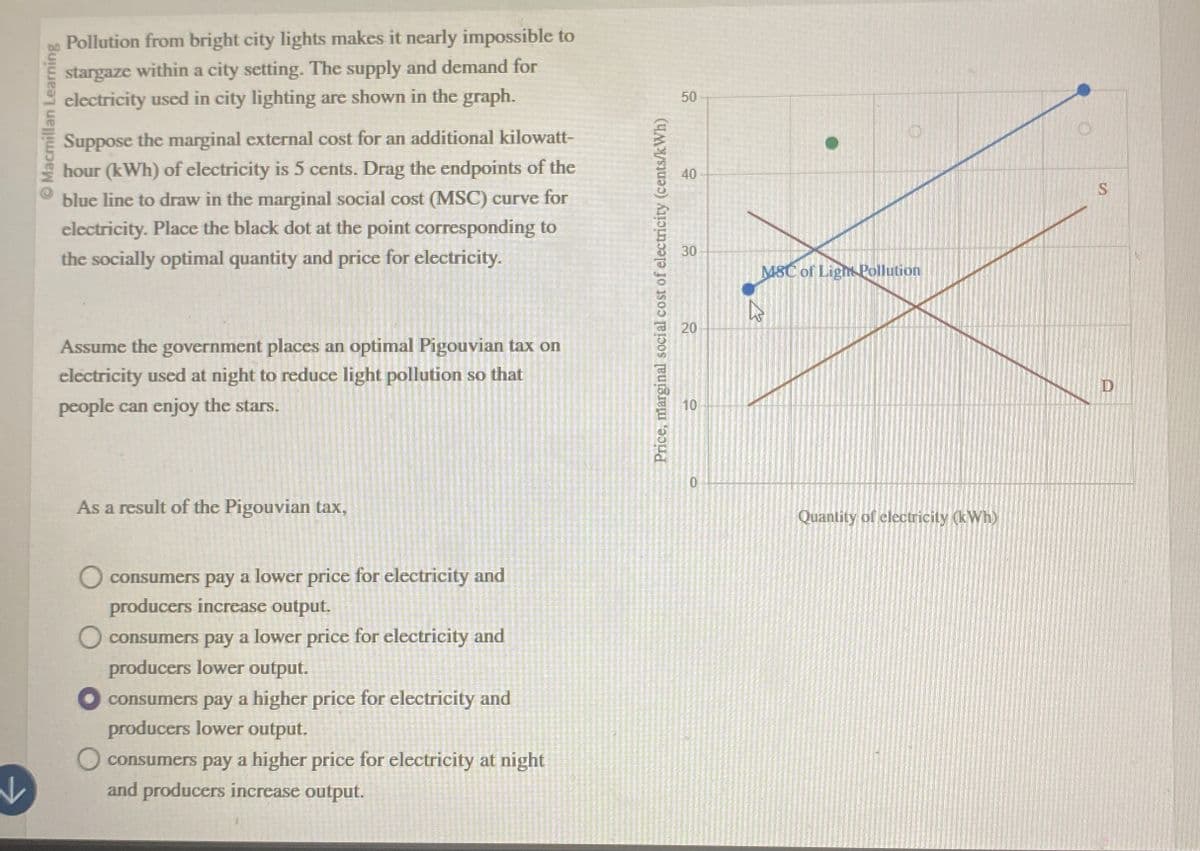Macmillan Learning Pollution from bright city lights makes it nearly impossible to stargaze within a city setting. The supply and demand for electricity used in city lighting are shown in the graph. Suppose the marginal external cost for an additional kilowatt- hour (kWh) of electricity is 5 cents. Drag the endpoints of the blue line to draw in the marginal social cost (MSC) curve for electricity. Place the black dot at the point corresponding to the socially optimal quantity and price for electricity. Assume the government places an optimal Pigouvian tax on electricity used at night to reduce light pollution so that people can enjoy the stars. As a result of the Pigouvian tax, consumers pay a lower price for electricity and producers increase output. consumers pay a lower price for electricity and producers lower output. consumers pay a higher price for electricity and producers lower output. consumers pay a higher price for electricity at night and producers increase output. Price, marginal social cost of electricity (cents/kWh) 50 50 10 40 30 M8C of Light Pollution 20 20 10 0 12 Quantity of electricity (kWh) S D
Macmillan Learning Pollution from bright city lights makes it nearly impossible to stargaze within a city setting. The supply and demand for electricity used in city lighting are shown in the graph. Suppose the marginal external cost for an additional kilowatt- hour (kWh) of electricity is 5 cents. Drag the endpoints of the blue line to draw in the marginal social cost (MSC) curve for electricity. Place the black dot at the point corresponding to the socially optimal quantity and price for electricity. Assume the government places an optimal Pigouvian tax on electricity used at night to reduce light pollution so that people can enjoy the stars. As a result of the Pigouvian tax, consumers pay a lower price for electricity and producers increase output. consumers pay a lower price for electricity and producers lower output. consumers pay a higher price for electricity and producers lower output. consumers pay a higher price for electricity at night and producers increase output. Price, marginal social cost of electricity (cents/kWh) 50 50 10 40 30 M8C of Light Pollution 20 20 10 0 12 Quantity of electricity (kWh) S D
Chapter8: Market Failure
Section: Chapter Questions
Problem 2P: Draw a standard supply and demand diagram for televisions, and indicate the equilibrium price and...
Question

Transcribed Image Text:Macmillan Learning
Pollution from bright city lights makes it nearly impossible to
stargaze within a city setting. The supply and demand for
electricity used in city lighting are shown in the graph.
Suppose the marginal external cost for an additional kilowatt-
hour (kWh) of electricity is 5 cents. Drag the endpoints of the
blue line to draw in the marginal social cost (MSC) curve for
electricity. Place the black dot at the point corresponding to
the socially optimal quantity and price for electricity.
Assume the government places an optimal Pigouvian tax on
electricity used at night to reduce light pollution so that
people can enjoy the stars.
As a result of the Pigouvian tax,
consumers pay a lower price for electricity and
producers increase output.
consumers pay a lower price for electricity and
producers lower output.
consumers pay a higher price for electricity and
producers lower output.
consumers pay a higher price for electricity at night
and producers increase output.
Price, marginal social cost of electricity (cents/kWh)
50
50
10
40
30
M8C of Light Pollution
20
20
10
0
12
Quantity of electricity (kWh)
S
D
Expert Solution
This question has been solved!
Explore an expertly crafted, step-by-step solution for a thorough understanding of key concepts.
This is a popular solution!
Trending now
This is a popular solution!
Step by step
Solved in 2 steps

Recommended textbooks for you

Exploring Economics
Economics
ISBN:
9781544336329
Author:
Robert L. Sexton
Publisher:
SAGE Publications, Inc


Economics (MindTap Course List)
Economics
ISBN:
9781337617383
Author:
Roger A. Arnold
Publisher:
Cengage Learning

Exploring Economics
Economics
ISBN:
9781544336329
Author:
Robert L. Sexton
Publisher:
SAGE Publications, Inc


Economics (MindTap Course List)
Economics
ISBN:
9781337617383
Author:
Roger A. Arnold
Publisher:
Cengage Learning


Principles of Economics 2e
Economics
ISBN:
9781947172364
Author:
Steven A. Greenlaw; David Shapiro
Publisher:
OpenStax
